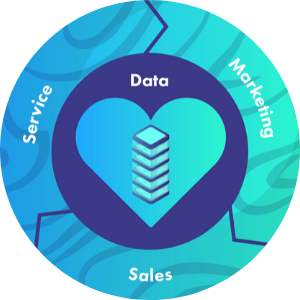Who Are Your Real Digital Competitors?
Review Your Strategy
You’ll never understand who your real competitors are if you don’t understand who your real customers are.
So who are your best customers? Who are your Pareto superstars, the 20% of your clients that drive 80% of your business?
Why did they choose you? Why do they stick with you? Why are you of value to them? Why would they stay (or leave)?
Which of these business-critical customers will accelerate your marketing flywheel with glowing recommendations and video testimonials that help you to secure new business?
Identify (and worship) these A1 customers. Analyse what would happen to your business if:
- best case scenario…you could gain more of them (and/or increase their customer lifetime value)
- worst case scenario…one of your competitors wooed them away.
Those are the real competitors you need to worry about most – the ones who can make or break you by snaffling (or unwittingly gifting you) your very best clients.
Not just the competitors whose offer threatens the tactical launch of this month’s shiny new product. Think about the big players who are (or could soon be) all over you strategically.
Or the smart little guy on the other side of the world with a game-changing solution that could disrupt your entire industry sector…
Which Channels Matter Most? Who’s Muscling In?
We won’t bore you with that Sun Tzu quote because you’ve seen it in a million business books and blog posts. But it’s worth taking it a stage further and opining that you’ll never truly know your enemy until you know yourself.
Once you’ve done that, and once you’ve identified your company’s bedrock customers, you need to confirm:
- how they found you – which channels do they use?
- who are your most dangerous and immediate competitors in those channels.
It’s tempting to personify your competitors as arch nemeses – shadowy bad guys, moustache-twirling silent movie rotters in stovepipe hats and black capes.
But the reality is that your competitors are probably just like you: friendly, smart and technically savvy guys and gals who are very good at what they do. And that makes them dangerous.
Finding Your Organic Competitors
Organic search is a fabulous channel because it’s the gift that keeps on giving. Get your SEO right and it will continue to deliver valuable traffic for free month after month. Plate-spinning perpetual motion par excellence.
For that reason, many companies have come to depend heavily on it. Perhaps too heavily. Google’s algorithm is as unpredictable and capricious as the sea. It’s not above throwing a few squalls or tempests your way with its frequent algorithm changes.
.jpg?width=1920&name=image%20(36).jpg)
But that algorithm is critically important – as anyone who has ever obsessed about keyword rankings will tell you. It’s right up there with Bill Shankly’s view of football (ie, more serious than life and death).
Good SEO tools will tell you:
- which keywords and search terms are (or should be) driving your best traffic (and to which pages)
- which competitors are standing in your way
- what you need to do to beat them.
Google Analytics offers invaluable insights into your own site’s performance. Search Console (formerly Webmaster Tools) is equally glorious; its list of organic search terms that drive traffic to your website is sheer gold. So too are its Coverage (indexing) and Links (backlinks) reports.
But to see what your competitors are really up to, you need specialist SEO software. Without it, you risk competing on an uneven playing field: your competitors will be checking you out…but you’ll be flying blind.
A good rank-checking tool is essential. It should show you not just your keyword positions but also which of the ever-burgeoning features you’ve secured on page one of Google:
- Basic ranking – and by how many places it has risen or fallen
- Featured snippet (aka the much-coveted and highly lucrative ‘position zero’)
- Knowledge Panel
- Local Pack
- Images
- Google Reviews
- Sitelinks
- ‘People also ask…’
- PPC ad position.
You should be able to see your overall search visibility, compared with your competitors. This is a useful ‘headline level graph’ which allows you to:
- track your organic search visibility progress over time – has it risen or fallen?
- benchmark your site against chosen competitors.
Search visibility line graphs are very good at showing you trends at-a-glance. And they’re good at showing how you’re faring against your chosen competitors. They’re very handy for telling you precisely when you (or your chosen competitors) suddenly got a boost or took a hit from the Google algorithm. So you can figure out why.
But they won’t show you sufficient detail. And they can lull you into a false sense of security. Without digging deeper, you may miss a crucial keyword that is suffering.
So you’ll have to dig deep into the data that usually sits under the graph. Check out the:
- Rankings
- Rankings distribution – by what percentage has your share (and your chosen competitors’ share) of visibility risen or fallen
- Pages – which key pages are getting the most rankings action from keywords? Have they risen or fallen?
- Featured Snippets – what are the best featured snippet opportunities in terms of search volume? Who currently holds the snippet position zero? How far are you behind?
And you absolutely must check out the performance of crucial keywords in the real battleground – page one of Google. When it comes to detailed diagnosis, there’s no substitute for rolling up your sleeves and getting stuck in the old school way – use your most important keywords to carry out de-personalised incognito (Shift+Ctrl+N) searches.
That will tell exactly who your real competitors are – not just the companies you think are your main rivals. It will tell you whether the chosen competitors you decided to benchmark yourself against in your SEO tool are the right ones.
So review your benchmarking. And pit yourself against your real organic search competitors.
Local Search For Local People!
The importance of local search cannot be overstated in B2C. It is absolutely vital.
Many B2B players find it less important but you still can’t afford to ignore it. Do so and your competitors will build up Google Reviews and NAP citations while your thoughts are elsewhere.
Then one day your local listings fall out of the three-pack…taking a chunk of your organic search traffic with them. By then you realise it’s too late to play catch-up: your competitors are so far ahead you’ll never claw back that lost ground.
So don’t ignore local search. You risk losing customers on your doorstep if you do. Google My Business will be your best friend but don’t ignore Bing and Apple.
Again, there are smart SEO tools that will help you to check your rankings against your chosen competitors. But again the best away to find your real competitors is to head to page one of Google and do those old school manual checks.
That means ensuring that you have the all the right ‘service in location’ keywords – ie, ‘widget manufacturer in Bournemouth’, ‘Poole widget manufacturers’, ‘widget manufacturer near me’ and so on.
Use SEO tools such as Moz Local to check Citations/NAP listings. See which directories:
- list their address (and how consistent those listings are)
- list their opening hours
- show a photo of their premises.
Check SEMRush to see which keywords your rivals rank for in the local pack.
And take a good look at their Google Reviews – how many do they have? Are they good reviews? Bad? Indifferent?
Do they have more reviews than you? Are they better than yours? If so, don’t just sit there seething with envy – go out and get some more reviews. Prioritise it. Be proactive.
PPC: Finding Your Google Ads Competitors

Basics
For a start you should always do some manual searches in Google to see whose adverts are appearing next to yours. That will give you some key names to investigate further.
Using Google’s Ad Preview and Diagnosis tool will enable you to search without triggering real impressions that would adversely affecting your clickthrough rate (and therefore your keyword Quality Score…and ultimately how much you pay for each click.)
The Ad Preview and Diagnosis tool makes it easy to switch location, language, device and audience for more accurate searching.
Okay, so now you have a basic list of potential rivals.
But do you have them all? What if a key competitor’s ad didn’t show on that particular manual search?
This is where the Google Ads Auction Insights comes into play…
Auction Insights
Auction Insights will give you a good steer on:
- who’s bidding against you
- impression share – how often their ads appear compared with yours
- overlap rate – how often your ads appear together
- position above rate – how often their ads outrank yours
- top of page rate – how often their ads are in the top four
- absolute top of page rate – how often their ads are in position one
- outranking share – how often your ads appeared above theirs.
You can gain valuable insights at account, campaign and ad group level. Can you drill down to keyword level? In theory ‘no’…but in practice ‘yes’ if you’ve been granular and kept to one keyword per ad group.
Will Auction Insights tell you who your real competitors are? Yes and no. It will tell you who your PPC competitors are – the people bidding against you. Sadly, that may include complete muppets who are bidding on the wrong keywords!
Are these muppets competitors?
- No – they’re in a completely different industrial sector!
- Yes – they’re forcing up PPC bids (costing you money) and snaffling impression share!
“Yeah-but-no-but …” Discuss.
So far, so good. The Google Ads interface is pretty obliging when it comes to telling you who your paid search competitors are. Reasonably helpful but not 100% – there is still vital information missing from the big picture…
Specialist PPC Tools
As with SEO organic search, it’s well worth using a smart PPC tool to hunt down your paid search competitors.
Simply by inputting a competitor’s domain, you can uncover which PPC keywords they’re using, their ad positions and how hard it will be to leapfrog them.
Importantly, it will also tell you how much search volume (over 12 months) each keyword will produce so you don’t go chasing rainbows simply because “they’re ranking for it so we must too”.
Also expect to see for each of your competitor’s keywords:
- average cost per click
- estimated traffic
- percentage of traffic driven to that website (how important it is to them)
- cost
- cost percentage (how much of their budget they’re spending on it)
- competitive density of advertisers (how big a scrum it is)
- number of other websites displayed in organic searches for that keyword
- trend – interest levels (in searches) over 12 months.
Dig a little deeper and you can see:
- their ads for each keyword
- a complete history of their ad positions for each keyword over the last year
- all their PPC landing pages
- any subdomains.
‘Awesome’ doesn’t begin to cover it.
This is the kind of detail that will help to determine how serious a threat your competitors really are: whether they’re sponsoring the right keywords (the ones you want) or whether they’re just hosing cash at Google.
Finding Your Social Media Competitors
Social media is a useful weapon in your arsenal but don’t bet the farm on it.
Google Analytics will tell you that – at a headline level – social media probably doesn’t result in many direct conversions but don’t write it off. You need to think beyond ‘last click’ attribution.
Digging into the Top Conversion Paths will tell you what part social media played in the chain of clicks that eventually led to a conversion. And which network can claim the glory.
For B2B, that is most likely to be LinkedIn but it could also be YouTube (also the world’s second largest search engine) or Q&A sites such as Stack Exchange or Quora.
So who are your competitors on LinkedIn?
By now you will probably have a good idea. The usual suspects will have kept rearing their competitive little heads when you did your organic and Google Ads research.
Armed with these names, you can then delve into LinkedIn and check out their company page, key players, engagement levels (and key engagers), top performing posts plus various groups.
How serious are they? How well built are their page and profiles? How good is the content they’re sharing? How much engagement is it getting? Who are their key players? Where do they hang out? With whom?
You may find that one of your most serious competitors in the real world actually has a lousy LinkedIn page with poor branding, basic errors/omissions, few posts and zero engagement. Good – capitalise on their mediocrity. Make great strides with your page while they continue to plod along.
Or you may discover that a peripheral minnow of a rival actually has quite a good page – maybe better than yours. Fine – learn from it and do better.
LinkedIn Ads
The world’s greatest B2B social network has never been the cheapest place to advertise. But it’s looking increasingly attractive as Account Based Marketing (ABM) gains traction (and ROI from Google Ads wanes).
Are your competitors advertising on LinkedIn? It’s easy to check. Go to their company page and click Ads in the left sidebar dropdown. If they’re advertising you’ll see ads that have been shown to at least one LinkedIn member in the last six months.
But beware the old temptation of “if they’re doing it, we must too”. Yes, give LinkedIn a go but don’t copy your rival’s methods slavishly. This powerful platform offers some excellent ad formats and great audience targeting options.
So be like Sinatra – do it your way. We can help.
How Many Direct Visits/Sessions Are Your Competitors Getting?
The quickest and easiest way is to check is using an SEO tool such as SEMRush. Simply type in your competitor’s domain, check the traffic analytics and up pop some handy graphs.
You can sense a ‘but’ coming though, can’t you?
Recent months have seen an increase in spammy Direct traffic. The first clue is an increase in your site’s overall bounce rate. And a quick dibble into Google Analytics will tell you that huge numbers of those bouncy ricochet visits are coming from Chicago.
It’s time to dig deeper. Segment your traffic. Look at just Direct traffic – exclude all other types. Go to Audience/Technology/Network. And there’s your culprit…Microsoft Corporation. You can filter it out but it’s extremely annoying.
A look at one client’s website showed that – between October and December last year – 71.93% of their Direct traffic was down to Microsoft Corporation as a service provider. And 99.80% of it bounced.
And if it can happen to your website, it can happen to your competitors’ sites too. So have a think before you accept your competitors’ headline Direct traffic figures as gospel.
They may be inflated by bouncy junk sessions. Ask yourself: “Would I expect a website of that size/age/quality to get that many Direct sessions? Does their brand presence suggest that it’s a plausible figure?”
Pick Your Battles
Identifying your true competitors and finding their weak spots is vital if you’re going to pick your battles wisely.
There’s no point getting emotional about a perceived competitor and steaming in with ill-thought campaigns. That’s a waste of time and money. It’s the digital equivalent of the Charge of the Light Brigade (and look how that ended for Lord Cardigan’s lot).
So be nerdy and do your research first. It’s far better to be an ‘anorak’ than a ‘Cardigan’.
Need Help?
Anxious at the prospect of all this detailed research? Don’t have time? Or the right digital tools?
Fear not – an Intergage Marketing Opportunity Analysis will strip your competitors naked and expose their secret weaknesses. They’d be terrified if they could see how deeply we can delve into their online presence with our powerful SEO and PPC tools!
So get in touch if you need some Intergage digital firepower…you’ll love it when a Marketing Opportunity Analysis comes together.






